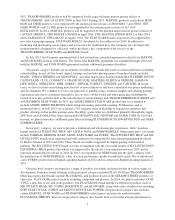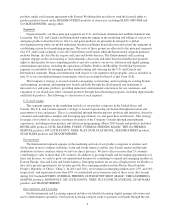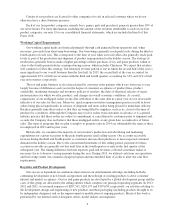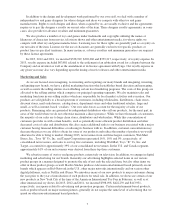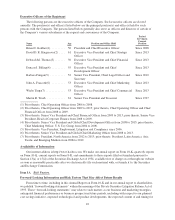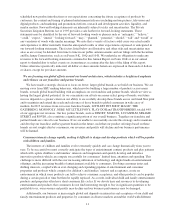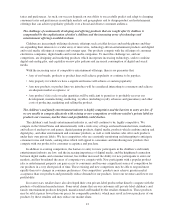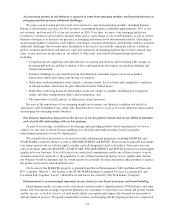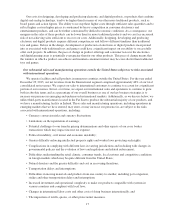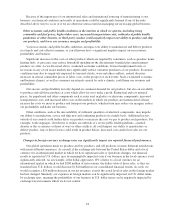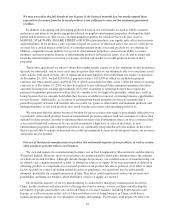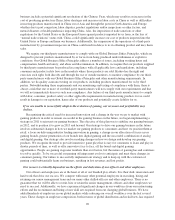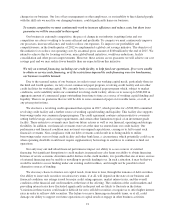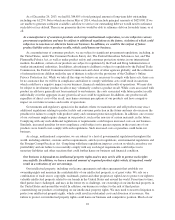Hasbro 2013 Annual Report Download - page 25
Download and view the complete annual report
Please find page 25 of the 2013 Hasbro annual report below. You can navigate through the pages in the report by either clicking on the pages listed below, or by using the keyword search tool below to find specific information within the annual report.An inability to develop and introduce planned products, product lines and new brands in a timely and cost-
effective manner may damage our business.
In developing products, product lines and new brands we have anticipated dates for the associated product
and brand introductions. When we state that we will introduce, or anticipate introducing, a particular product,
product line or brand at a certain time in the future those expectations are based on completing the associated
development, implementation, and marketing work in accordance with our currently anticipated development
schedule. There is no guarantee that we will be able to manufacture, source and ship new or continuing products
in a timely manner and on a cost-effective basis to meet constantly changing consumer demands. This risk is
heightened by our customers’ compressed shipping schedules and the seasonality of our business. The risk is also
exacerbated by the increasing sophistication of many of the products we are designing, and brands we are
developing in terms of combining digital and analog technologies, utilizing digital media to a greater degree, and
providing greater innovation and product differentiation. Unforeseen delays or difficulties in the development
process, significant increases in the planned cost of development, or changes in anticipated consumer demand for
our products and new brands may cause the introduction date for products to be later than anticipated or, in some
situations, may cause a product or new brand introduction to be discontinued.
United States, global and regional economic downturns that negatively impact the retail and credit markets,
or that otherwise damage the financial health of our retail customers and consumers, can harm our
business and financial performance.
We design, manufacture and market a wide variety of entertainment and consumer products worldwide
through sales to our retail customers and directly to consumers. Our financial performance is impacted by the
level of discretionary consumer spending in the markets in which we operate. Recessions, credit crises and other
economic downturns, or disruptions in credit markets, in the United States and in other markets in which our
products are marketed and sold can result in lower levels of economic activity, lower employment levels, less
consumer disposable income, and lower consumer confidence. Similarly, reductions in the value of key assets
held by consumers, such as their homes or stock market investments, can lower consumer confidence and
consumer spending power. Any of these factors can reduce the amount which consumers spend on the purchase
of our products. This in turn can reduce our revenues and harm our financial performance and profitability.
In addition to experiencing potentially lower revenues from our products during times of economic
difficulty, in an effort to maintain sales during such times we may need to reduce the price of our products,
increase our promotional spending and/or sales allowances, or take other steps to encourage retailer and
consumer purchase of our products. Those steps may lower our net revenues or increase our costs, thereby
decreasing our operating margins and lowering our profitability.
Challenging market conditions in certain developed economies, such as in the United States, Canada,
Australia and certain Western European countries, make it more difficult for us to succeed.
Our future success in the United States, Canada, Australia, Europe and other developed economies is
impacted by market conditions. For example, a European sovereign debt crisis or other significant negative shock
to European markets could lead to a recession in Europe, which may negatively impact consumers and in turn,
sales of our products in the European markets. Similar negative events impacting the market in the United States
and other developed economies may harm our business.
Many categories within the toy, game and family entertainment industries in the United States, Canada,
Australia, certain Western European countries and other developed economies have not grown, or in some cases
have even declined, in recent years. In addition, many current economic predictions suggest developed
economies may grow only modestly, if at all, in the next several years. We have substantial business in
developed economies, and these markets represent a majority of our current product sales. It is more difficult for
us to grow, or even maintain, our business when the overall market in certain of the major countries we serve is
not growing or is declining. To succeed in a market that is stable or declining, we must maintain or gain market
share from our competitors, which is more difficult than growing in an expanding market. As long as economic
conditions in the developed economies remain difficult, this will be an additional challenge for the Company.
13


